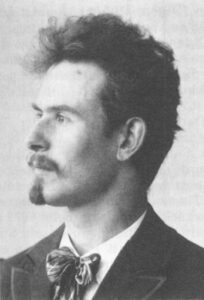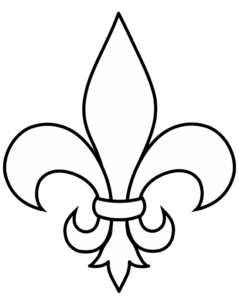 Hermann Heinrich August Oetken
Hermann Heinrich August Oetken
Hermann Heinrich August Oetken was born on February 14th 1868 in Oldenburg as the son of the farmer Diederich Oetken and Maria Katarzyna née Scheide. After graduating from high school, in the years 1885–1888, he studied painting in his hometown, in the studio of the then famous stage designer, Wilhelm Mohrmann (1849–1934). In 1888, he worked in the office of architect Ludwig Klingenberg (1840–1924), where he mastered the skill of drawing and architectural painting. Together, they also made a research trip to Spain and France.
In 1890, he moved to Hanover, where he became a student of prof. Hermann Schaper (1853–1911). Together with him, he worked on decorating and renovating historic buildings. In 1891, his first published works appeared – 20 penned vedutes created on the occasion of the 50th anniversary of the Oldenburgischer Gerwerbe– und Handelsverein. Three years later, Ludwig Klingenberg commissioned him to create a fresco with a horse portrait of Count Anton-Günther (1583–1667) on the wall of one of the oldest houses in Oldenburg.
In 1895 he left Schaper’s studio and set up his own in Berlin. The high number of orders proves the level of his work. In 1897, the Deutsche Glasmosaik-Anstalt Puhl & Wagner company from Rixdorf commissioned him to develop two mosaics for the rebuilt Melanchthon House in Bretten. At the turn of 1897–1898, he made a mosaic design at Maria Lach Abbey in the Rhineland. In 1898 he took part in the Great Berlin Art Exhibition. A year later, he painted the Adoration of the Shepherds in the vestibule of the Church of Mary Magdalene in Halle. In the years 1899–1901 he worked on the decorations of the Kaiser-Wilhelm-Gedächtniskirche in Berlin. In 1900 he designed stained glass windows for the new synagogue in Dortmund, and the following year he made a fresco in Magdalenenkapelle in Moritzburg. When, in 1900, Emperor William II gave the Turkish Sultan Abdul Hamid II a monumental 12-meter fountain for the Topkapi Palace, Oetken designed its mosaic decorations. Other works worth mentioning include paintings in the Luther House in Eisleben (1902), a fresco on the facade of the Royal Biological Institute in Helgoland (1902), a mosaic in the Savior’s Chapel in Mirbach (1902-1903), stained glass windows in churches in Groß Lüben near Wittenberg and st. Paul in Halle and the Cistercian monastery in Heiligengrabe (1903–1904), polychromes of the church in Bad Schmiedeberg (1904–1905), mosaics in the Wilhelm Tower in Berlin and in the Imperial Palace in Poznań (1904–1910). Around 1910, he created a design for the polychrome in the church of St. Nicholas in Stralsund, and in 1913 he designed the furnishings of the chapel of the Imperial Palace in Poznań, following the example of the famous Capella Palantina in Palermo. In 1906, he was awarded the title of professor for a mosaic project in Elisabeth-Kemenate at the Wartburg castle. A year later he became a member of the Oldenburger Künstlerbund and took over the chair of medieval decorations at the Charlottenburg University of Technology, which he headed for almost 20 years.
Despite his independent orders, he did not cut off contacts with Hermann Schaper, who, at the peak of his popularity, in 1897 received another large order for work in the Malbork Castle. To meet it, he constantly enlarged the group of his associates. Together with Oetken they were created by: Karl Bohlmann (1877–1929), Heinrich Mittag (1859–1920), Ludwig Wilhelm Martin Morisse (1870–1936) and a painter named Bürma. It is possible that Oetken worked on the paintings in the Chapter House (1892–1898), the Convent’s Dining Room (1896) or the Great Refectory (1910).
When Hermann Schaper died in June 1911, the students finished the work in Malbork according to his designs. In the same year, Friedrich Schwarting (1883–1918) polychrome the western wall of the chapel of St. Anna. August Oetken, in 1915, performed three great figural scenes on the north wall of the Great Refectory: Establishment of Koenigsberg by King Ottokar of Bohemia in 1255, the suppression of the Great Prussian Uprising in 1265–1274 and the handing over to the Order of Bavaria’s banners in 1337.
After the end of World War I, Oetken dealt with, among others painting commemorative plaques in honor of fallen soldiers. In the years 1923–1925 he again collaborated with Puhl & Wagner, which made mosaics according to his old designs for the cathedral in St. Louis in the USA. His last major work were the polychromes of the church of St. Peter in Berlin-Lichterfeld (1926). After Hitler came to power, he stopped working. In 1944, after his house in Berlin had been demolished and his entire artistic output had been lost, he returned to Oldenburg. There, living in poverty, he painted small landscapes and still lifes. He died on May 20, 1951.
(compiled by R. Rzad)

